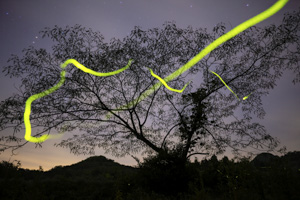Genjibotaru
The "Genjibotaru", a summer nighttime tradition in Japan, is a large firefly, about 20 mm long, whose larvae live in and around rivers to grow. Unlike the princess firefly, they fly with a green light that emits for several seconds. They are representative of the Japanese sense of beauty, "mono no ahare".
It is very difficult to count living things in a certain place, but it is very easy to count the fireflies that glow as they fly at night. That's why fireflies are a barometer of rich nature and biodiversity.
The common method for photographing "Genjibotaru" is to photograph the background in bright light and compare the light of the fireflies with a composite image, but I try to photograph "Genjibotaru" in a single shot, just as I do with "Himebotaru". This is because I think it expresses "mono no ahare" better.
日本では夏の夜の風物詩である「ゲンジ蛍」は、体長20mm程の大型の蛍で、幼虫が川で成長するために川の周辺に生息しています。姫蛍と違い緑色の光を数秒間放ちながら飛びます。日本の美意識である「もののあはれ」を代表する存在です。
ある場所にいる生物を数えるのはとても難しいですが、夜に飛びながら光る蛍を数えるのはとても簡単です。だから蛍は豊かな自然と生物多様性のバロメーターなのです。
ゲンジボタルの写真も明るいうちに背景を撮影して蛍の光を比較明合成する方法が一般的ですが、私はゲンジ蛍の撮影も姫蛍と同じく一枚撮りで撮影するようにしています。それは「もののあはれ」をより表現するものだと思うからです。




















